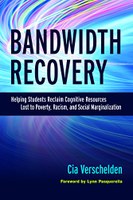Chronic Scarcity Impairs Learning Bandwidth: What We Can Do About It
Have you ever had to do without something….something you really needed? How did you feel? Were you more certain of yourself, and the ultimate good outcome? Probably not. We react to scarcity with uncertainty because the predictability of the future has been challenged. Most of us think of scarcity in financial terms, not enough money for food, clothing, or shelter. But what if it was not just scarcity of resources, but scarcity of respect, affirmation, or belonging? And, what if that scarcity was for a long period of time? Would a condition of the chronic scarcity of these things make uncertainty a way of life for you, rather than a transient condition? That is what poverty, social marginalization and racism can do to you. These issues are reviewed in depth in the book Bandwidth Recovery by Cia Verschelden1, which was recommended by this year’s visiting professor at the Delphi Center’s annual Celebration of Teaching and Learning. In short, chronic scarcity leads to chronic uncertainty.
transient condition? That is what poverty, social marginalization and racism can do to you. These issues are reviewed in depth in the book Bandwidth Recovery by Cia Verschelden1, which was recommended by this year’s visiting professor at the Delphi Center’s annual Celebration of Teaching and Learning. In short, chronic scarcity leads to chronic uncertainty.
With uncertainty…about the future, whether you belong, whether you are respected…comes a reduced ability to focus, to learn, to plan. This has a tremendous impact on bandwidth for student learning; especially, those from racial and ethnic minorities, LGBT students, first-generation college students, and anyone who feels like they just don’t fit in. The need for them to use bandwidth to process how and whether you belong, assess microaggressions, and face stereotype threats, impacts their available bandwidth for learning.
So why should we, as educators, care about this? We should care because colleges and professional schools are venues that allow students to forge a new version of themselves as they learn. And, as educators, we should be concerned with maximizing human capacity by teaching effectively with the goal of student learning, and anything that reduces bandwidth for learning should concern us. What can we do about it?
Solutions reside at the faculty and university level. As faculty members we must strive in every teaching setting to create inclusive learning environments that help all learners know they belong and can learn regardless of bandwidth challenges. Here are five guiding principles that faculty can use to take practical steps toward a more inclusive teaching environment:
- Establish and support a class climate that fosters belonging for all students
- Set explicit student expectations in a learner-centered syllabus
- Select course content that recognizes diversity and acknowledges barriers to inclusion
- Design all course elements for accessibility
- Reflect on your beliefs about teaching to maximize self-awareness and commitment to inclusion
For those of us responsible for classroom teaching, we can utilize a curriculum design format called Universal Design for Learning (UDL). Practicing the principles of UDL means offering our students multiple means of engagement, multiple means of representation, and multiple means of action and expression.
"UDL asks us to stop thinking about disability and accommodations as somehow deviating from the desired norms for teaching and learning, and instead challenge ourselves to create a learning space that might not need to make accommodations in the first place...this requires a fundamental commitment to equity" - Kevin Gannon, Radical Hope2
But there are three strategies that reside at the system-level to helping students recover learning bandwidth:
- Commit to recruiting and retaining a critical mass of minority faculty. Students of negatively stereotyped racial, socioeconomic, or ethnic groups may perform less well in college, at least partially because of the pressure of identity threat that depletes mental bandwidth for learning. One condition alleviates that pressure: minority professors. Recruiting and retaining a critical mass of faculty at least in the same proportions as the student population is the key.
- Assure that images on campus reflect the diversity of the student body to assist ethnic and racial minority students in feeling like they belong. Students visiting the campus are looking for cues in public spaces that they will fit in and will belong at your school. Assure that images on posters, billboards and websites communicate that students of color are welcome, are valued, and that they, too, can succeed.
- Set up mechanisms to assist with financial needs of students beyond tuition and books. The biggest barrier to poor students' enrolling or staying in college is not tuition and fees, but everything else: rent, food, gas, child-care, phone bills, etc. Living costs represent more than 70% of the total cost of attending a two-year college. Consider how the institution can provide food scholarships and rent subsidies.
One can look to the success achieved at Georgia State University in minority student retention and graduation rates by implementing these strategies. Since 2003, GSU has instituted over a dozen system-level strategic programs all focused on increasing student success by removing institutional barriers and threats to mental bandwidth. GSU has increased overall graduation rate from 32% in 2003 to a six-year graduation rate of 53% in 2019. For more information, see this short video clip.
Recognizing that our undergraduate, graduate and professional school students could be experiencing reduced bandwidth for learning, and them implementing faculty-level and system-level strategies to help them to recover bandwidth are vital steps to take if we are to make UofL a Great Place to Learn for all students.
Resources:
1. Verschelden, C. (2017). Bandwidth recovery: helping students reclaim cognitive resources lost to poverty, racism, and social marginalization. Stylus.
2. Gannon, K. M. (2020). Radical hope: a teaching manifesto. West Virginia University Press.